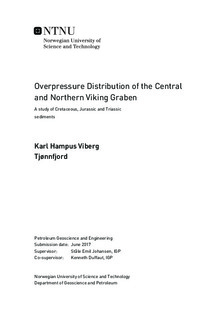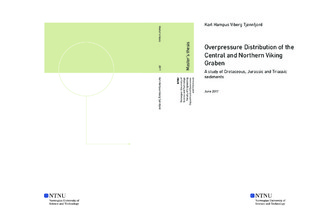| dc.description.abstract | The North Sea was subjected to massive faulting during the Jurassic period, resulting in a complex graben structure. Consequently, the Viking Graben is heavily compartmentalized and overpressures occur within the Jurassic and Triassic sediments. The distribution of overpressure has therefore been investigated. The aim of this report is to estimate the distribution of overpressured sediments around the Viking Graben, on the Norwegian continental shelf. In order to do so, the lateral and vertical boundaries of the compartments must be established, and any pressure generating events must be identified.
Seismic sections were analyzed for any geological features deemed relatable to overpressure and for both vertical and lateral sealing events. The upper boundary of overpressure was determined by comparing the seismic with well-log responses. Suitable anomalies found on the well-logs were determined as upper boundaries. Faults were investigated to determine if they could be sealing. Mud weight calculations were performed to establish the different magnitudes of the pressure compartments.
The pressure calculations suggest a single high pressurized regime, up to 40 MPa overpressure, along the centre of the Viking Graben, and more compartmentalized regimes, with lower values of overpressure, towards the margins. Compartment boundaries are found to be related to larger faults, the base Cretaceous unconformity, and impermeable Lower Cretaceous sediments. Only the larger faults are assumed to be sealing so that pressure transference may occur across the smaller faults. Log responses clearly identified overpressures within the within the Lower Cretaceous sediments, proving the existence of pressure compartments in post-Jurassic sediments.
The pressure distribution falls within the expected pattern, with highest values at the centre of the graben and that deeply buried sediments become subjected to more overpressure. Overpressures within Jurassic and Triassic sediments are most likely caused by a combination of undercompaction and chemical diagenesis since none of the mechanisms can generate the overpressure alone. No definite cause of overpressure within the Lower Cretaceous has been determined either, but the presence of gas and leaks at the Cretaceous-Jurassic boundary suggest transference of fluids. The limited number of wells within the graben does have implications for the validity of the overpressure distribution at the centre. | |

